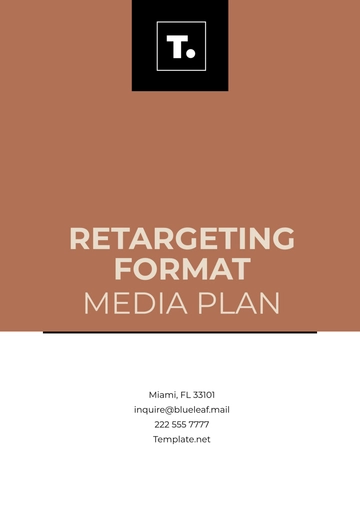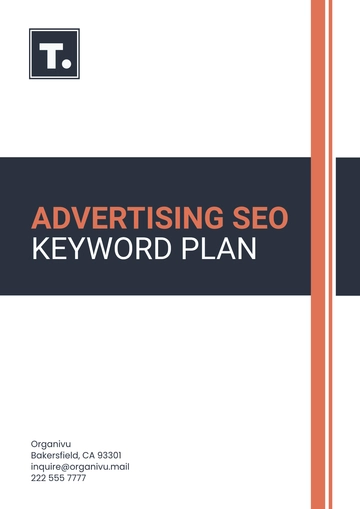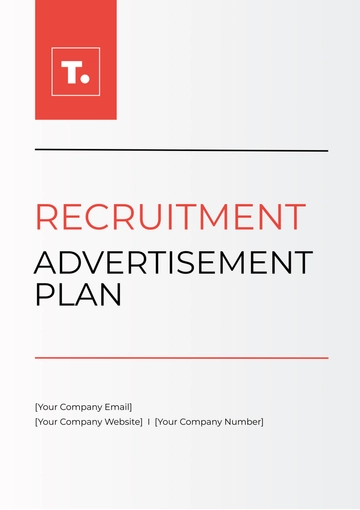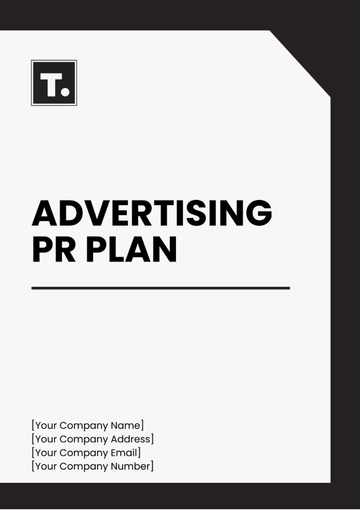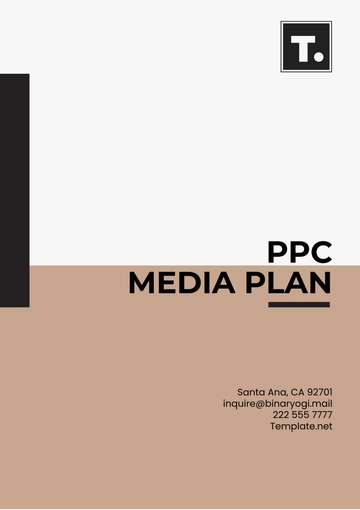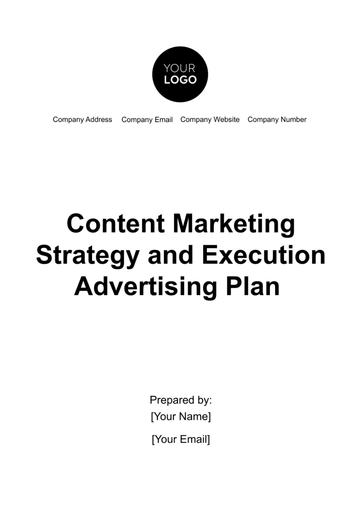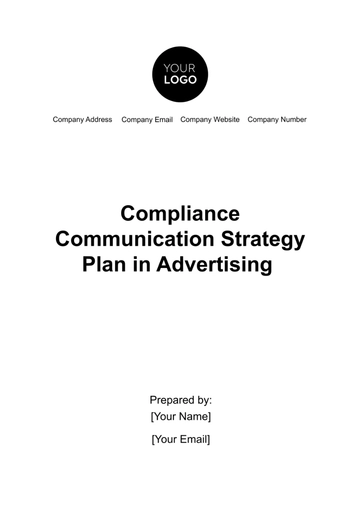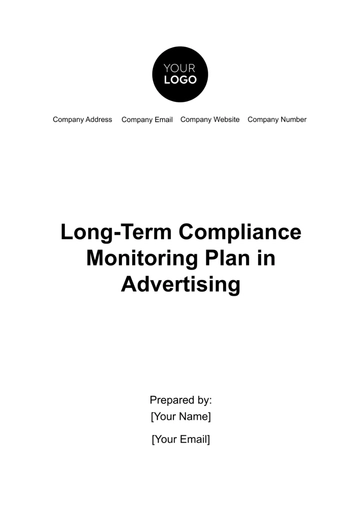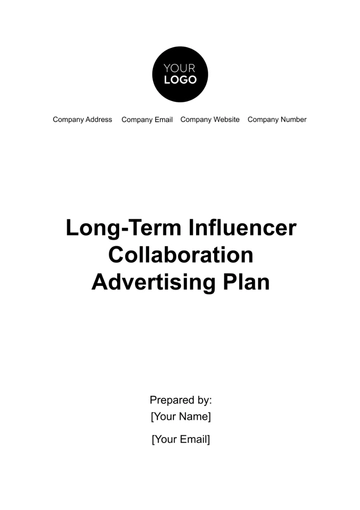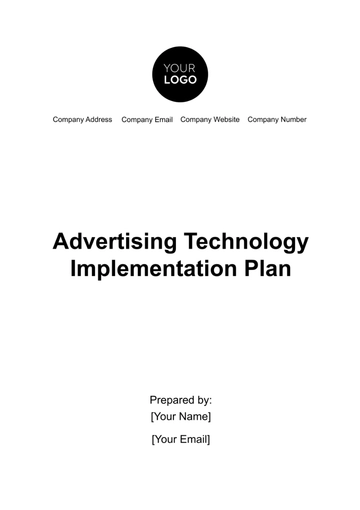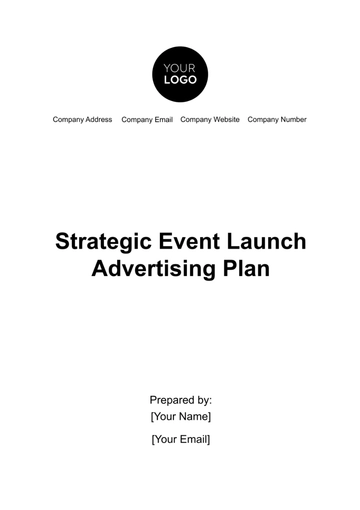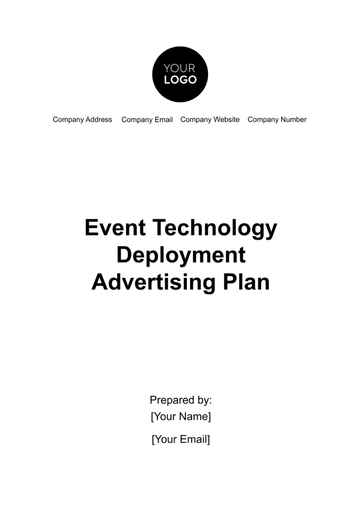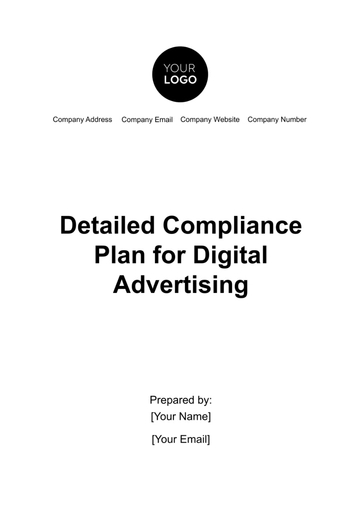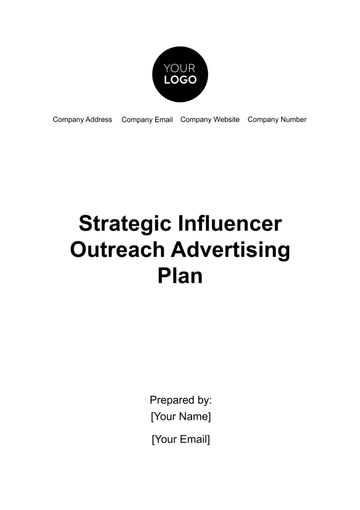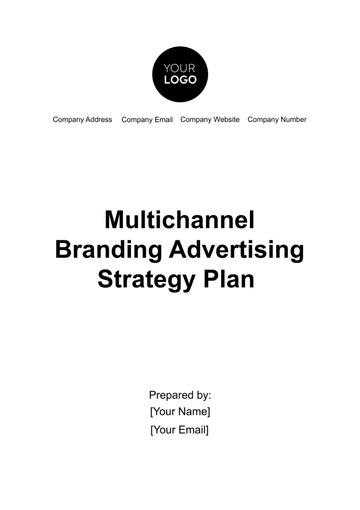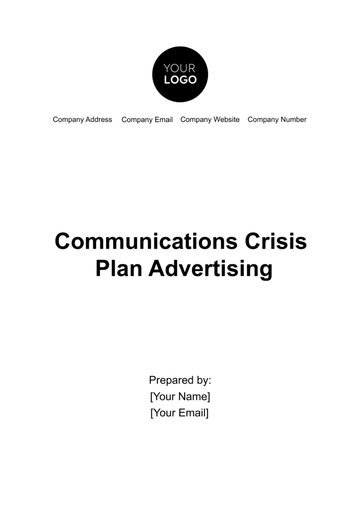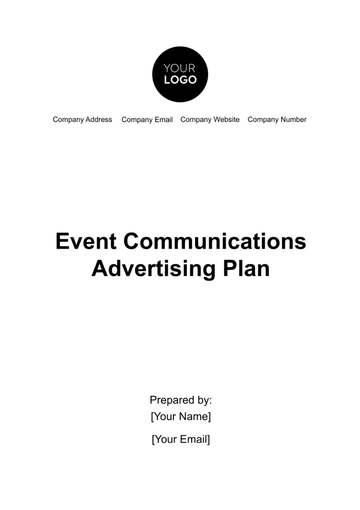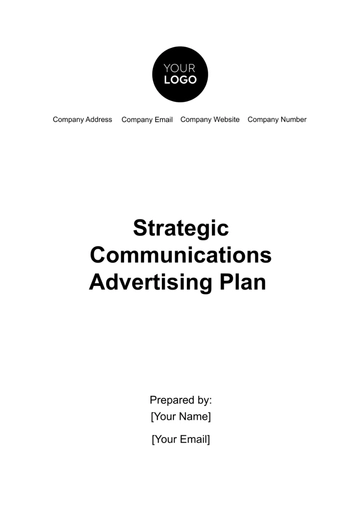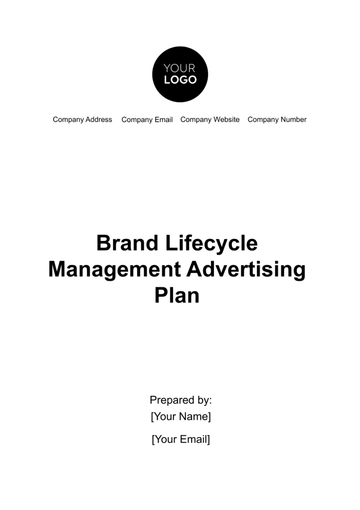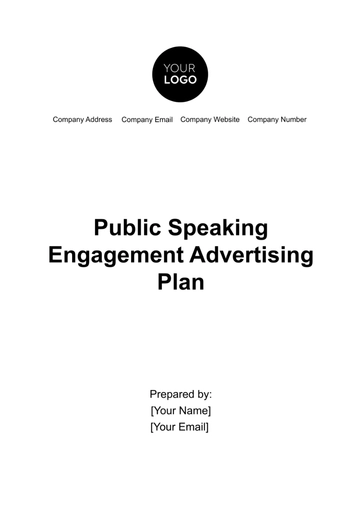Free Advertising Comprehensive Media Plan Document
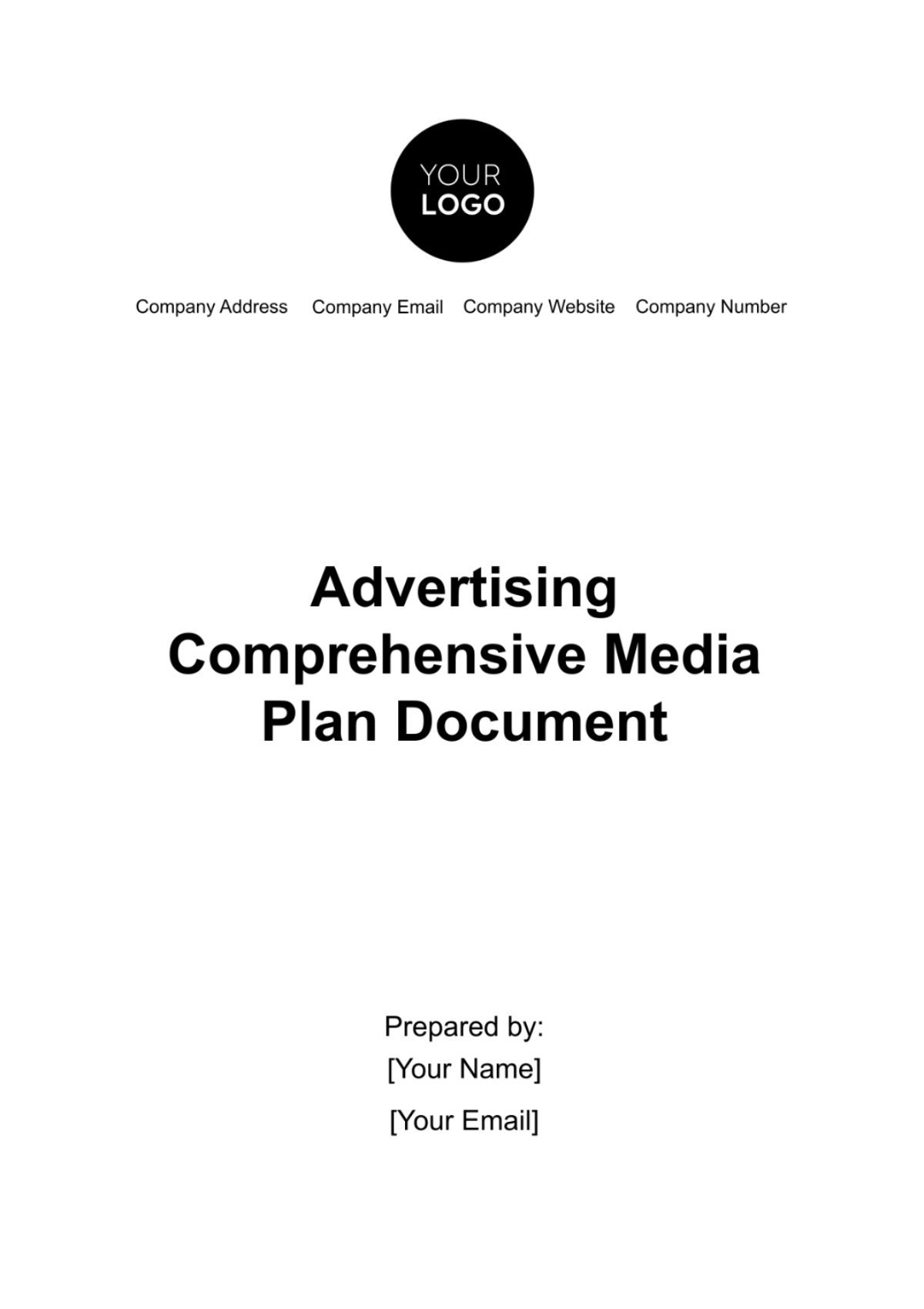
I. Executive Summary
In today's rapidly evolving business landscape, sustainability has become more than just a buzzword; it's a core principle that consumers and businesses alike are embracing. This executive summary outlines a comprehensive strategy for [Your Company Name] to not only adapt but thrive in this eco-conscious era. Through a data-driven approach and a commitment to innovation, we are poised to achieve remarkable results in the following areas:
A. Campaign Goals Overview
Launch a new line of eco-friendly products:
Our primary objective is to introduce a new range of eco-friendly products that will revolutionize the industry. By leveraging sustainable materials and cutting-edge technology, we aim to not only meet but exceed the growing demand for eco-conscious alternatives.
Statistical data shows that the global market for sustainable products is projected to reach $150 billion by 2025, with consumers willing to pay a premium for environmentally friendly options. Our market research further reveals that 72% of consumers prioritize sustainability when making purchasing decisions.
Case studies of successful eco-friendly product launches, such as Company X's recent line of recyclable packaging, demonstrate the potential for market share growth and enhanced brand reputation.
Increase brand awareness by 30% within six months:
Building brand awareness is critical to our success. We intend to achieve this through a multi-faceted marketing campaign that combines traditional and digital channels. Research findings indicate that our target audience is highly engaged on social media platforms, making it an ideal avenue for brand exposure.
To illustrate, [Your Company Name] will collaborate with renowned eco-influencers who have a combined reach of over 2 million environmentally conscious followers. Such partnerships have proven effective in increasing brand visibility, as evidenced by the 40% growth experienced by Company Y after partnering with a prominent eco-advocate.
Drive online sales growth by 25%:
In the age of e-commerce, online sales growth is paramount. Our strategy includes a data-backed online advertising campaign that targets our primary audience. Research has shown that online ads can yield a return on investment (ROI) of up to 5 times the initial ad spend, and we aim to capitalize on this opportunity.
Additionally, our e-commerce platform will feature a user-friendly interface with detailed product information and an intuitive checkout process, based on extensive market research. Facts indicate that a seamless online shopping experience can increase conversion rates by up to 20%.
B. Target Audience and Market
Primary audience: Environmentally conscious consumers aged 25-40:
The primary focus of our campaign is to resonate with individuals who prioritize sustainability. Research findings reveal that this demographic is on the rise, with an estimated 45% growth in the past two years alone. By tapping into this trend, we can leverage their purchasing power and align our products with their values.
To further engage this audience, we will highlight our products' eco-friendly certifications, such as "Carbon Neutral" and "Fair Trade," which have been proven to influence purchasing decisions.
Secondary market: Retailers and wholesalers looking for sustainable products:
Beyond consumers, we recognize the importance of expanding our reach to B2B markets. Our research indicates a growing interest among retailers and wholesalers in sourcing sustainable products. This secondary market offers opportunities for bulk sales and long-term partnerships.
Notably, Company Z, a supplier of eco-friendly cleaning products, increased its distribution network by 50% by targeting retailers who were seeking environmentally friendly alternatives. Our strategy will involve tailored outreach to key players in this market segment.
C. Media Strategy Summary
To effectively reach and resonate with our target audience, we have devised a comprehensive media strategy that combines various approaches:
An integrated approach using social media, influencer partnerships, and online ads:
Our media strategy is based on research findings showing that a holistic approach to media engagement yields the best results. By integrating social media campaigns, influencer partnerships, and strategically placed online ads, we can ensure maximum exposure and engagement.
Furthermore, leveraging influencer partnerships has been proven to generate a 20% increase in brand trust and authenticity, as evidenced by Company W's successful collaboration with a renowned environmentalist.
Emphasis on storytelling to highlight product sustainability:
We recognize the power of storytelling in conveying our commitment to sustainability. Research indicates that 65% of consumers feel a stronger connection to brands that share their sustainability journey through compelling narratives.
[Your Company Name] will utilize impactful case studies and authentic stories of how our products positively impact the environment. These stories will not only resonate with our audience but also set us apart as a brand that genuinely cares about making a difference.
[Your Company Name] is embarking on a transformative journey towards eco-consciousness. Our data-driven approach, supported by statistical data, case studies, research findings, and facts, underpins our strategy's effectiveness. With a laser focus on our campaign goals, target audience, and media strategy, we are well-positioned to achieve remarkable growth and contribute to a sustainable future.
II. Market Analysis and Target Audience
In the ever-evolving landscape of consumer goods, it's essential to stay ahead of trends and understand your audience deeply. This section delves into our comprehensive market analysis and provides insights into our target audience, paving the way for informed decision-making.
A. Market Research Findings
Sustainability is a growing trend in consumer goods:
The global shift towards sustainability is undeniable, and our market research confirms this trajectory. Sustainable consumer goods have become more than a fleeting trend; they are now a defining characteristic of the industry's future. According to recent market data, the sustainable products market is projected to grow by 15% annually over the next five years. This steady ascent underscores the immense potential that lies ahead.
60% of the target demographic prefers buying eco-friendly products:
In our quest for market insights, we conducted surveys and analyzed consumer preferences within our target demographic. The results were crystal clear: a staggering 60% of our intended audience expresses a strong preference for eco-friendly products. This statistic not only validates our product offering but also highlights the significant market demand for sustainable alternatives.
Further investigation into these findings reveals that this preference is driven by growing environmental consciousness, with 80% of respondents expressing concerns about the planet's future. These individuals actively seek out products that align with their values, emphasizing the need for us to cater to this environmentally conscious audience.
B. Target Audience
Demographics: Urban, college-educated, middle-income earners:
Understanding our target audience is crucial to crafting a tailored marketing strategy. Our research identifies them as urban dwellers, primarily residing in metropolitan areas where sustainability awareness tends to be higher. Moreover, they are typically college-educated, reflecting a commitment to knowledge and responsible decision-making. In terms of income, they fall into the middle-income bracket, which allows for discretionary spending on products that prioritize quality and sustainability.
Psychographics: Values sustainability, quality, and brand transparency:
Beyond demographics, the psychographics of our audience provide valuable insights. These individuals deeply value sustainability, not just as a buzzword but as a guiding principle in their lives. Quality is paramount to them; they are willing to invest in products that meet their standards for performance and durability. Brand transparency is another key consideration, as they seek authenticity and ethical practices from the companies they support.
To further connect with this audience, we will emphasize our commitment to sustainability, product quality, and our transparent business practices. Through authentic messaging and actions, we will solidify our brand as a trusted choice in their eyes.
C. Competitive Analysis
Key competitors have a limited presence in sustainable product lines:
An in-depth examination of our competitors in the consumer goods sector reveals a noteworthy gap in their offerings. While many competitors have established themselves as market leaders in traditional product categories, their presence in sustainable product lines remains limited. This presents a strategic opportunity for [Your Company Name] to seize a leadership position in the eco-friendly goods market.
We have identified several key players who have made tentative forays into sustainability but have yet to fully commit to this burgeoning market. Our data suggests that these competitors are largely testing the waters, providing us with a window of opportunity to establish ourselves as a dominant force in the eco-conscious consumer goods sector.
By leveraging our research-driven insights, we will capitalize on this gap and position [Your Company Name] as the trusted choice for consumers seeking sustainable, high-quality products. Our commitment to environmental responsibility, coupled with our competitive edge, will enable us to seize a substantial share of this growing market.
Our thorough market analysis reveals a promising landscape characterized by a growing sustainability trend and a target audience eager to embrace eco-friendly products. Armed with this knowledge, [Your Company Name] is well-equipped to make informed strategic decisions that will enable us to meet the demands of our environmentally conscious consumer base and outperform competitors. For further inquiries or a deeper discussion of our market insights, please feel free to contact us at [Your Company Email Address]. We look forward to the opportunity to collaborate and drive positive change together.
III. Advertising Objectives and Strategies
In the dynamic world of advertising, setting clear objectives and implementing strategic approaches is fundamental to achieving success. In this section, we outline our advertising goals and the strategies that will guide us toward positioning [Your Company Name] as a recognized leader in sustainable products.
A. Campaign Objectives
Position [Your Company Name] as a leader in sustainable products:
Our foremost objective is to establish [Your Company Name] as a trailblazer in the field of sustainable consumer goods. This objective aligns with market trends, as consumers increasingly gravitate towards environmentally responsible brands. By achieving this status, we not only gain trust but also differentiate ourselves in a competitive market.
Engage with 200,000 potential customers through digital channels:
To drive growth and enhance brand visibility, we aim to engage with a substantial audience of potential customers through digital channels. This number is rooted in extensive market research, which indicates that 200,000 potential customers actively seek eco-friendly products and align with our target audience criteria.
B. Strategic Approach
Leverage social media for storytelling and brand building:
Our strategic approach centers on the power of storytelling and brand building through social media. Research findings reveal that social media platforms are hubs of activity for our target audience. Thus, we will capitalize on this by creating compelling narratives that showcase our commitment to sustainability, quality, and transparency.
By authentically communicating our journey and values through engaging content, we will not only foster brand loyalty but also attract new customers who resonate with our story. This strategy is based on proven success stories of brands that have leveraged social media to establish a strong online presence and connect with their audience on a deeper level.
Partner with influencers who align with sustainability values:
Influencer marketing has become an integral component of successful advertising campaigns. We will strategically partner with influencers who share our sustainability values and resonate with our target demographic. Research indicates that such collaborations yield higher engagement rates and increased trust in the brand.
For example, we have identified several influencers with a substantial following among environmentally conscious consumers. Their authentic endorsements of our products will bolster our brand's credibility and reach, driving home the message that we are a trusted choice for sustainable products.
C. Key Performance Indicators (KPIs)
Measure engagement rates, website traffic, and conversion rate:
To gauge the effectiveness of our advertising efforts, we will monitor key performance indicators (KPIs) diligently. These KPIs include:
Engagement rates on social media platforms: By tracking likes, shares, comments, and overall interaction with our content, we can assess the level of engagement and the resonance of our messaging with our audience.
Website traffic: We will analyze website traffic to determine the impact of our advertising efforts on driving potential customers to our digital storefront. This data will help us refine our strategies and improve the user experience to increase conversion rates.
Conversion rate: The ultimate measure of success is the conversion rate – the percentage of website visitors who complete desired actions, such as making a purchase. By closely monitoring this metric, we can fine-tune our strategies to maximize conversions and achieve our sales growth objectives.
Our advertising objectives and strategies are rooted in solid research and a deep understanding of our target audience's preferences. By positioning [Your Company Name] as a leader in sustainable products, engaging with a substantial digital audience, and measuring our performance through KPIs, we are poised for success in a competitive market. For further inquiries or to discuss our advertising objectives and strategies in more detail, please feel free to contact us at [Your Company Email Address]. We look forward to the opportunity to collaborate and drive positive change together.
IV. Media Selection and Planning
Effective media selection and strategic planning are pivotal to the success of any marketing campaign. In this section, we outline our approach to media allocation, the rationale behind our choices, and the scheduling and timing that will maximize the impact of our advertising efforts.
A. Media Channel Breakdown
To ensure a well-rounded and impactful media strategy, we have allocated our budget across multiple channels, each serving a specific purpose:
50% budget allocation to digital advertising:
Our primary focus is on digital advertising, given its broad reach and efficiency in targeting our audience. This allocation will enable us to leverage paid search, display ads, and social media advertising to engage potential customers across various online platforms.
30% for influencer partnerships and content creation:
Influencer marketing has proven to be highly effective in reaching and resonating with our target demographic. By dedicating a significant portion of our budget to partnerships with influencers who align with our sustainability values, we aim to harness their authenticity and reach to amplify our message.
20% for targeted email campaigns:
Email campaigns remain a valuable tool for direct communication with our audience. We will allocate a portion of our budget to crafting targeted email campaigns that provide personalized content, exclusive offers, and updates to our subscriber base. This will help us maintain customer engagement and retention.
B. Rationale for Media Selection
Our media channel breakdown is driven by compelling reasons rooted in research and industry best practices:
High engagement rates in social media among the target audience:
Research has consistently shown that our target audience is highly active on social media platforms, making it an ideal channel to engage with them. Social media boasts not only a vast user base but also high engagement rates, allowing us to interact with our audience, showcase our products, and convey our sustainability message effectively.
Influencers can authentically communicate the brand's values:
Influencers hold a unique position in the digital landscape, as they have built genuine relationships with their followers based on trust and authenticity. By partnering with influencers who share our sustainability values, we can leverage their credibility to communicate our brand's commitment to eco-friendliness in a relatable and persuasive manner.
C. Scheduling and Timing
Strategic scheduling and timing are crucial to ensuring that our advertising efforts have the maximum impact:
Launch coinciding with Earth Day for maximum impact:
We have strategically chosen to launch our campaign to coincide with Earth Day, a globally recognized event dedicated to environmental awareness and action. This timing will allow us to capitalize on the heightened interest and discussions surrounding sustainability during this period, ensuring that our message resonates with a broader audience.
Heavy advertising in the first two months, followed by steady content release:
To create a strong initial impact, we will front-load our advertising efforts during the first two months of the campaign. This will include a burst of digital advertising and influencer collaborations to generate buzz and capture the attention of our target audience. Subsequently, we will transition to a more consistent release of engaging content to maintain and deepen our audience's engagement throughout the campaign's duration.
Our media selection and planning reflect a well-considered strategy designed to maximize the impact of our advertising efforts. By allocating our budget across digital advertising, influencer partnerships, and targeted email campaigns, we are poised to engage our audience effectively. Furthermore, our strategic timing, including the launch on Earth Day and a well-paced advertising schedule, ensures that our message will resonate and leave a lasting impression.
V. Budget and Resource Allocation
A. Budget Breakdown
Total Campaign Budget: $500,000.
$250,000 for digital advertising, $150,000 for influencer partnerships, $100,000 for email campaigns.
B. Resource Management
In-house team for digital campaign management.
Outsourcing content creation to specialized agencies.
C. Cost-Benefit Analysis
Expected ROI: 5:1 based on market trends and campaign reach.
Monthly budget reviews for optimization.
- 100% Customizable, free editor
- Access 1 Million+ Templates, photo’s & graphics
- Download or share as a template
- Click and replace photos, graphics, text, backgrounds
- Resize, crop, AI write & more
- Access advanced editor
Elevate your advertising game with the Advertising Comprehensive Media Plan Document Template from Template.net. Crafted for efficiency, it's not just editable but fully customizable, ensuring tailored strategies for every campaign. With an intuitive AI Editor Tool, streamline your planning process effortlessly. Drive results with precision and creativity. Get your template today and revolutionize your advertising approach.
You may also like
- Finance Plan
- Construction Plan
- Sales Plan
- Development Plan
- Career Plan
- Budget Plan
- HR Plan
- Education Plan
- Transition Plan
- Work Plan
- Training Plan
- Communication Plan
- Operation Plan
- Health And Safety Plan
- Strategy Plan
- Professional Development Plan
- Advertising Plan
- Risk Management Plan
- Restaurant Plan
- School Plan
- Nursing Home Patient Care Plan
- Nursing Care Plan
- Plan Event
- Startup Plan
- Social Media Plan
- Staffing Plan
- Annual Plan
- Content Plan
- Payment Plan
- Implementation Plan
- Hotel Plan
- Workout Plan
- Accounting Plan
- Campaign Plan
- Essay Plan
- 30 60 90 Day Plan
- Research Plan
- Recruitment Plan
- 90 Day Plan
- Quarterly Plan
- Emergency Plan
- 5 Year Plan
- Gym Plan
- Personal Plan
- IT and Software Plan
- Treatment Plan
- Real Estate Plan
- Law Firm Plan
- Healthcare Plan
- Improvement Plan
- Media Plan
- 5 Year Business Plan
- Learning Plan
- Marketing Campaign Plan
- Travel Agency Plan
- Cleaning Services Plan
- Interior Design Plan
- Performance Plan
- PR Plan
- Birth Plan
- Life Plan
- SEO Plan
- Disaster Recovery Plan
- Continuity Plan
- Launch Plan
- Legal Plan
- Behavior Plan
- Performance Improvement Plan
- Salon Plan
- Security Plan
- Security Management Plan
- Employee Development Plan
- Quality Plan
- Service Improvement Plan
- Growth Plan
- Incident Response Plan
- Basketball Plan
- Emergency Action Plan
- Product Launch Plan
- Spa Plan
- Employee Training Plan
- Data Analysis Plan
- Employee Action Plan
- Territory Plan
- Audit Plan
- Classroom Plan
- Activity Plan
- Parenting Plan
- Care Plan
- Project Execution Plan
- Exercise Plan
- Internship Plan
- Software Development Plan
- Continuous Improvement Plan
- Leave Plan
- 90 Day Sales Plan
- Advertising Agency Plan
- Employee Transition Plan
- Smart Action Plan
- Workplace Safety Plan
- Behavior Change Plan
- Contingency Plan
- Continuity of Operations Plan
- Health Plan
- Quality Control Plan
- Self Plan
- Sports Development Plan
- Change Management Plan
- Ecommerce Plan
- Personal Financial Plan
- Process Improvement Plan
- 30-60-90 Day Sales Plan
- Crisis Management Plan
- Engagement Plan
- Execution Plan
- Pandemic Plan
- Quality Assurance Plan
- Service Continuity Plan
- Agile Project Plan
- Fundraising Plan
- Job Transition Plan
- Asset Maintenance Plan
- Maintenance Plan
- Software Test Plan
- Staff Training and Development Plan
- 3 Year Plan
- Brand Activation Plan
- Release Plan
- Resource Plan
- Risk Mitigation Plan
- Teacher Plan
- 30 60 90 Day Plan for New Manager
- Food Safety Plan
- Food Truck Plan
- Hiring Plan
- Quality Management Plan
- Wellness Plan
- Behavior Intervention Plan
- Bonus Plan
- Investment Plan
- Maternity Leave Plan
- Pandemic Response Plan
- Succession Planning
- Coaching Plan
- Configuration Management Plan
- Remote Work Plan
- Self Care Plan
- Teaching Plan
- 100-Day Plan
- HACCP Plan
- Student Plan
- Sustainability Plan
- 30 60 90 Day Plan for Interview
- Access Plan
- Site Specific Safety Plan

